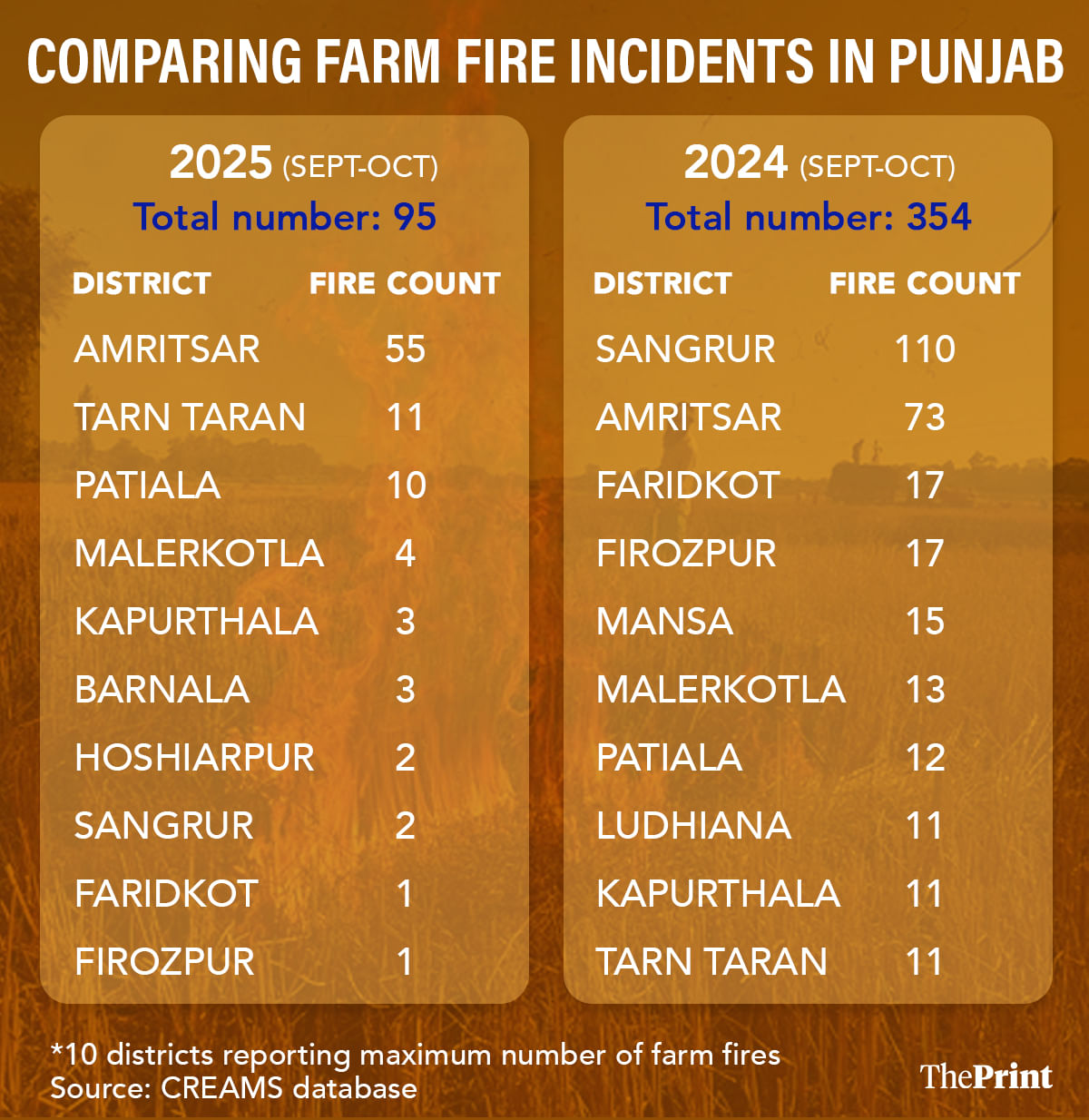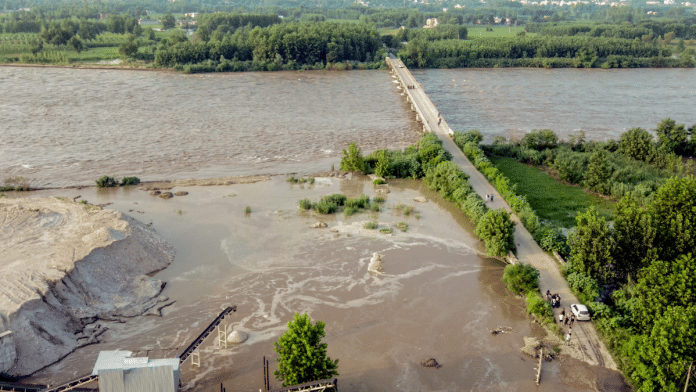New Delhi: Punjab could see a drastic drop in stubble-burning cases this year due to the devastating floods in August that left a large swathe of agricultural land under water and flattened crops across the state.
A Punjab Pollution Control Board official said that with a sizable number of farmers facing crop losses and fields in parts of the state still under the silt and stagnant water, the scope for stubble-burning at the end of the rice harvest season has reduced.
“We will see a much better Diwali this time, not a smog-filled one like last year,” Sandeep Behl, a senior environmental engineer at the Punjab Pollution Control Board told ThePrint. “We expect stubble-burning cases to reduce drastically in Punjab this year. The floods have definitely had an impact, and even otherwise, the government is doing its best to reduce (farm) fires and impose penalties (on offending farmers).”
According to remote sensing data by the Indian Agricultural Research Institute (IARI)’s dataset by CREAMS (Consortium for Research on Agroecosystem Monitoring and Modeling from Space), Punjab recorded 95 farm fire incidents from 20 September to 5 October, significantly lower than 354 during the corresponding period last year and 214 the year before.
“There should be stubble left for people to burn—right now the farmers are still recovering from the floods,” said Guramneet Singh, a farmer from Ludhiana’s Mangat village and a member of Bharatiya Kisan Union. “Stubble arises if you have actually harvested the crops, and most of us haven’t done that.”
Also Read: Farm fires caused just 4% of Delhi’s air pollution, vehicles main culprit, finds pre-Diwali analysis
The August floods
Due to heavy rains and overflow of the Ravi, Sutlej and Beas rivers towards the end of August, massive floods inundated more than 1,000 villages in Punjab. The floods led to 55 deaths and also affected more than 4 lakh hectares of farmland, leading to major crop losses. The floods impacted the paddy crops just as they were about to be harvested, leading to many farmers losing their entire yield of the season.
Another remote sensing dataset by PGIMER Chandigarh pegs Punjab’s total farm fires at 145 from 20 September to 5 October this year, which is still lower than the number of incidents in previous years.
Senior PGIMER scientist Professor Ravindra Khaiwal said the base data used by both CREAMS and PGIMER is from NASA’s remote sensing centre, and despite the slight mismatch, the signs are pointing in the same direction.
“This year, I think we’ll see a 50-70% reduction in stubble burning cases in Punjab due to the floods, and other reasons,” said Khaiwal. “There were a total of 12,000 cases from Punjab in the entire stubble burning season last year, this year I believe we might see only around 6,000-7,000 cases.”
However, both Khaiwal and Behl were quick to add that the overall impact of reduced stubble burning in Punjab on air pollution in the region, including the national capital, remains to be seen as the season progresses. Other factors, including farm fires in other northern Indian states and across the border in Pakistan, could also play a role.
New Delhi and the national capital region witness a spike in pollution levels during winter months, and among other factors it is also blamed on stubble-burning in neighbouring states of Punjab and Haryana.
Districts witnessing stubble-burning cases
Out of the total stubble-burning cases recorded this year in Punjab by both CREAMS and PGIMER datasets, around half are in Amritsar. According to Amritsar Chief Agricultural Officer (CAO) Baljinder Bhullar, this is because of the sowing of early varieties of paddy in this region.

“The Amritsar district has around 1,80,000 hectares of farm land, and 30,000 hectares of this is sown with early varieties of paddy and harvest early too,” explained Bhullar. “That is why the farm fires always start in Amritsar, because they’re the first to harvest.”
Most paddy crops are harvested at the end of September/early October in Punjab, but in Amritsar, the early varieties are harvested by mid-September. While the yield is lower this time around due to the floods and other reasons, the harvest did happen on time and most of the stubble-burning cases recorded this year are from this region.
The top five districts in terms of stubble-burning cases this year include Amritsar, Tarn Taran, Patiala, Malerkotla and Kapurthala. However, in previous years, districts like Sangrur, Faridkot and Firozpur too regularly featured on this list— their notable absence this year is because most farmers in the region are reeling from flood losses.
“There are fields that have 4-5ft tall sand dunes and silt accumulation after the floods. This has completely flattened the crops, and even clearing the field will take a long time,” explained Guramneet Singh. “Forget stubble-burning, this is going to impact even the wheat sowing season for many farmers.”
Impact on total yield in Punjab
Like Singh, many farmers in Punjab are concerned about the overarching impacts of the floods, resultant plant diseases, and current rainfall trends on the overall agricultural yield. According to Singh and Bhullar, paddy yield in the state is expected to drop by 15-20 percent this year, because of a number of reasons.
“The normal yield per acre is 24-26 quintals of paddy, but this year we’ll see around 18-19 quintals I think,” estimated Singh, who is involved in relief operations across the state. “Even the fields that survived the floods were affected by the loose smut disease which reduced their harvest.”
After harvesting the paddy crop in October, farmers usually till the land and prepare it for the rabi season wheat crop which is to be sowed by the first week of November. However, this year, most farmers are still dealing with the damage brought on by the rivers.
“They need heavy machinery to remove the mounds of silt that have accumulated on fields. The machinery is difficult to acquire for many small farmers,” said Anil Beniwal, a farmer from Haryana’s Jind district who aided in relief operations in Punjab. “Some of us Haryana farmers have provided equipment, diesel for machinery and other aid to the Punjab ones, but the government needs to do more too.”
Apart from silt, many other farms in Punjab have also seen water stagnation, which has flattened the crops entirely. Singh said many farmers are struggling to drain their fields now, so as to have dry soil to till and sow wheat later.
“The government is cracking down on stubble-burning farmers as usual, but what about flood relief? The Supreme Court can order to put farmers in jail for burning stubble, but not order government officials to help the struggling farmers after these floods?” questioned Singh, referring to the SC’s 17 September observation to consider penal provisions for stubble burning.
(Edited by Ajeet Twari)
Also Read: Farmers outwitting satellite detection? Images show stubble burning peak post-afternoon hours






